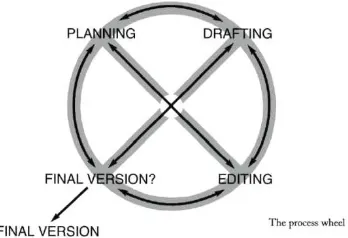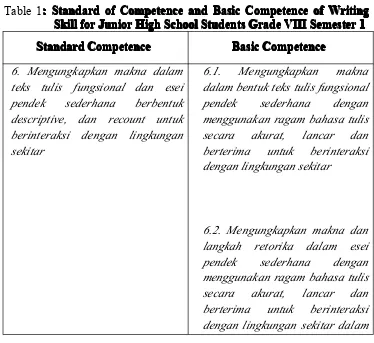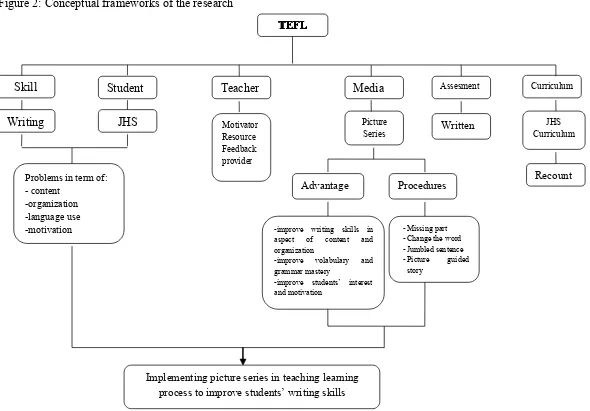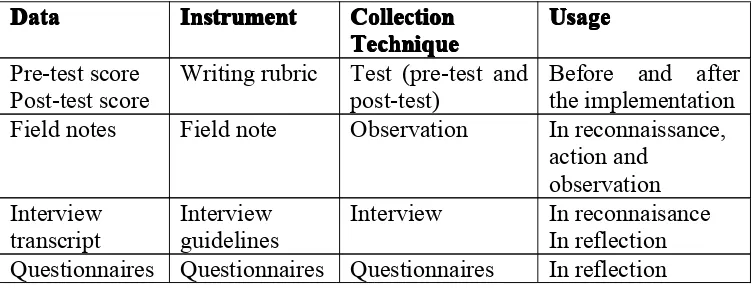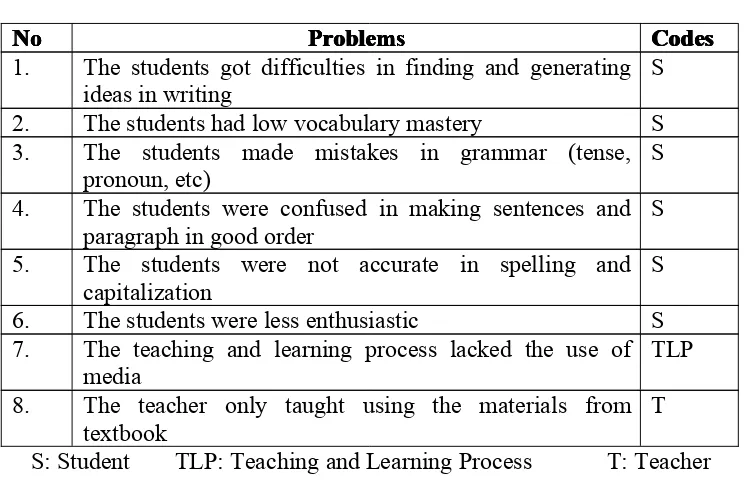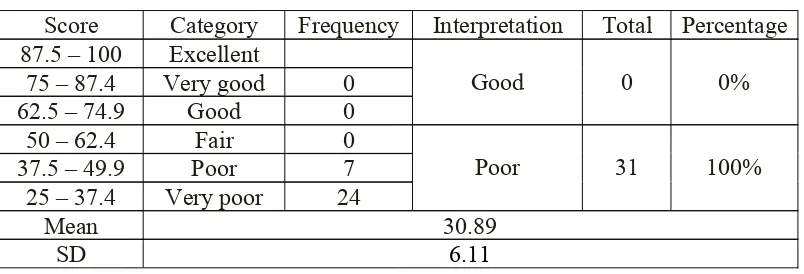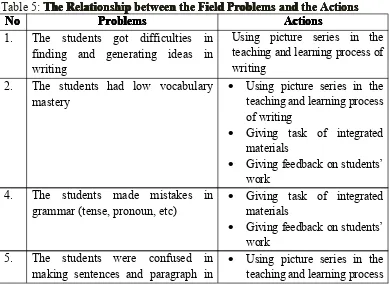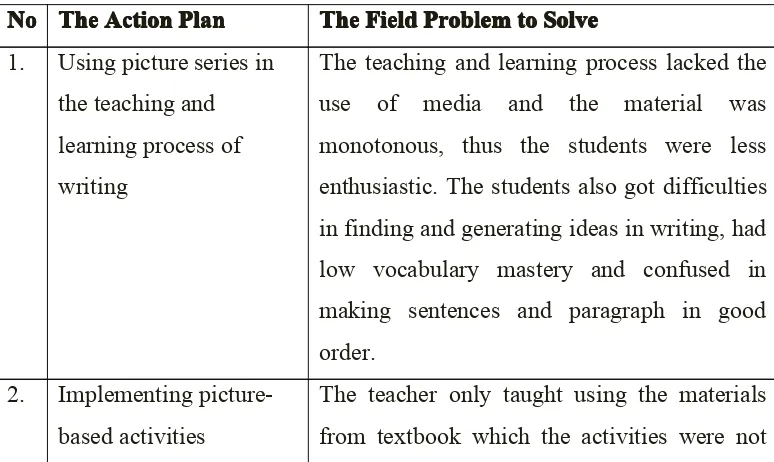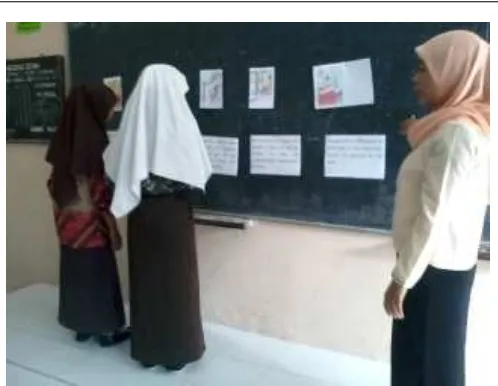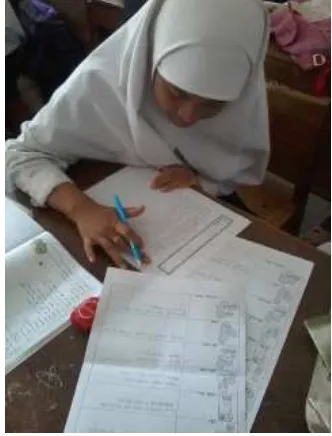A Thesis
Presented as a Partial Fulfillment of the Requirements for the Attainment of the Sarjana Pendidikan Degree in English Language Education
Fatikhah Ismawati 09202241069
ENGLISH EDUCATION DEPARTMENT FACULTY OF LANGUAGES AND ARTS YOGYAKARTA STATE UNIVERSITY
ii
APPROVAL SHEET
IMPROVING WRITING SKILLS THROUGH PICTURE SERIES OF THE EIGHT GRADE STUDENTS OF SMP NEGERI 1 GAMPING
A Thesis
by
Fatikhah Ismawati 09202241069
Approved on July , 2014
by
First Consultant, Second Consultant,
iii
RATIFICATION
IMPROVING WRITING SKILLS THROUGH PICTURE SERIES OF THE EIGHT GRADE STUDENTS OF SMP NEGERI 1 GAMPING
Accepted by the Board of Examines of English Education Department, Faculty of Languages and Arts, Yogyakarta State University on July 2014 and declared to have fulfilled the requirements to attain Sarjana Pendidikan Degree in English Education.
BOARD OF EXAMINERS
Chairperson : Jamilah, M.Pd. 1. ……….
Secretary : Sudiyono, S.Pd.,M.A. 2. ……….
Examiner 1 : Siti Sudartini, M. A 3. ……….
Examiner 2 : Dra. R.A. Rahmi D. Andayani, M.Pd. 4. ……….
Yogyakarta, July 2014 Faculty of Languages and Arts
Yogyakarta State University Dean,
iv Nama : Fatikhah Ismawati
NIM : 09202241069
Program Studi : Pendidikan Bahasa Inggris
Fakultas : Bahasa dan Seni Universitas Negeri Yogyakarta
JudulSkripsi : Improving Writing Skills Through Picture Series In Grade 8th SMP Negeri 1 Gamping
menyatakan bahwa karya ilmiah ini dalah hasil pekerjaan saya sendiri. Sepanjang pengetahuan saya, karya ilmiah ini tidak berisi materi yang ditulis oleh orang lain, kecuali bagian-bagian tertentu yang saya ambil sebagai acuan dengan mengikuti tata cara dan etika penulisan karya ilmiah yang lazim.
Apabila ternyata terbukti bahwa pernyataan ini tidak benar, sepenuhnya menjadi tanggung jawab saya.
Yogyakarta, Juli 2014 Penulis
v
DEDICATION
~This thesis is fully dedicated to my beloved
vi MOTTO
"I y
,
y y
”
vii
ACKNOWLEDGEMENTS
All praise is to Allah, the Almighty, the Merciful, for the blessing given to me so that I could finish this thesis. I would also like to thank all of those who have given support, guidance, and assistance without which I would have never finished my study.
My deepest appreciation and gratitude are addressed to my consultant, Dra. R.A. Rahmi D. Andayani, M.Pd. and Sudiyono, S.Pd.,M.A. who have given me valuable support, encouragement and suggestions in the process of writing this thesis. I would also like to express my appreciation to all lecturers at English Education Department of Yogyakarta State University for the valuable knowledge, lessons, guidance, and encouragement they give during my academic years.
I also feel grateful for being a part of the family of SMP Negeri 1 Gamping. I would like to thank Drs. Bambang (the school principal), Suryo Winasto A. Md. Pd (the English teacher of class VIII), and all the students especially in class VIII A.
I would like to thank my collaborators, Neni Oktaviani and Gallis Nawang Ginusti, for sharing and giving advice and suggestions during the research.
My gratitude goes to my beloved parents and my family, who always become my spirit in my life. Their loves, supports, and prayers lead me to reach my success and dreams.
Many thanks are also addressed to my friends in English Education Department 2009, especially my classmates in Class D, also for Anton Toheri Kurni Marifa, Ditta Mustika, Farhan Maftuh, and Joko Priyono for the support and motivation, wonderful friendships and the beautiful moments we have been through together.
viii
thesis will give some contributions to the improvement of the English teaching and learning.
Yogyakarta, July 2014
ix
TABLE OF CONTENTS
Page TITLE PAGE ...………...
APRROVAL SHEET ………
RATIFICATION ………...
PERNYATAAN...………...
DEDICATIONS ……… MOTTOS....……… ACKNOWLEDGEMENTS …..……… TABLE OF CONTENTS ……….. LIST OF TABLES ………
LIST OF FIGURES ………...
LIST OF APPENDICES ………..……….
ABSTRACT ………...
CHAPTER I INTRODUCTION
A. Background of the Study ……….……….... B. Identification of the Problem ………... C. Problem Limitation………...…………... D. Problem Formulation ………... E. The Objectives of the Study ………. F. The Significance of the Study………...
CHAPTER II LITERATURE REVIEW& CONCEPTUAL FRAMEWORK
A. Theoritical Description ………….………...
1. Writing ………..
a. Definition of Writing………...
b. Process of Writing………
c. Types of Writing Performances………
x
d. Micro and Macro Skills of Writing………..
2. Teaching Writing ………..
a. Principles of Teaching Writing ……… b. The Roles of the Teacher ………..…….………... c. Approaches to Teaching Writing………..
a) Product-Oriented Approach ……… b) Process-Oriented Approach ……… d. Teaching Writing in Junior High School……….
3. Pictures ………..
a. Advantages ……….
b. Procedures ………...
B. Related Study………
C. Conceptual Framework ………...
CHAPTER III RESEARCH METHODS
A. The Setting of the Study ..……….. B. Subjects of the Research .……….
C. Research Design………
D. Type of Data ………....
E. Techniques and Instruments of Data Collection………...…... F. Data Analysis Techniques………... G. Validity and Reliability ……….... H. Indicators of Success….………
CHAPTER IV RESEARCH FINDINGS
A. Reconnaisance..………....……….
B. Report of Cycle 1 ………....………...
a. Planning ………...
b. Action and Observation ………...
xi
a. Planning ………..……….
b. Action and Observation ……….…….…….
c. Reflection ………...……..
D. General Findings and Discussion..……….
CHAPTER V CONCLUSION, IMPLICATIONS, & SUGGESTIONS
A. Conclusions...………..
B. Implications ……….
C. Suggestions ………..
REFERENCES………..………
APPENDICES ..……….
76 78 82 90
99 100 100
xii
LIST OF TABLES
Table Page
Table 1: Standard of Competence and Basic Competence of Writing Skill for Junior High School Students Grade VIII Semester 1..
23
Table 2: Types of data, instruments, and data collection techniques of
the research.………...
35
Table 3: The Field Problems in the English Teaching and Learning Process of Grade VIII A of SMP Negeri 1 Gamping…………
45
Table .4: The Students’ Writing Score in the Pretest……….. 47 Table 5: The Relationship between the Field Problems and the Action.. 48 Table 6: The Action Plans and the Field Problems to Solve in Cycle 1.. 50 Table 10: The Action Plans and the Field Problems to Solve in Cycle 2.. 76 Table 11: The Questionnaire Result on the benefits of using picture
series in term of writing aspects………
84
Table 12: The Questionnaire Result on the benefits of implementing picture series in term of students’ motivation..………
85
Table 13: The Students’ Writing Score in Cycle 2 …..…… 89 Table 14: The Comparison of the Students’ Writing Skills Cycle 1 and
Cycle 2………...
89
Table 15: The Result of t-test – Cycle 1 and Cycle 2…... 89 Table 16: The Change Result of the Improvement of the Action during
Cycle 1 and Cycle 2………...
90
Table 17: Students’ Mean Value of Writing in the Pretest, Cycle 1,
Cycle 2………...
94
xiii
Cycle 1, and Cycle 2……….. Table 19: The Comparison of the Students’ Writing Skills in the Pretest
and the Posttest………..
95
xiv
LIST OF FIGURES
Figure Page
Figure 1: The process wheels of writing suggested by Harmer (2004)…. 12
Figure 2: 2The Conceptual Framework of the Research……… 31
Figure 3: The students play a game of arranging “Holiday In Scotland” story………. 56 Figure 4: The student write a story based on picture series……… 65
Figure 5: Student’s writing in pre-test……… 69
Figure 6: Student’s’s writing after cycle 1……… 70
Figure 7: Student’s’s writing after cycle 1……… 86
Figure 8 Student’s’s writing in Post test 86
Figure 9: The Chart of Students’ Writing Score in the Pretest, Cycle 1 (Posttest1), Cycle 2 (Posttest1)………
xv
LIST OF APPENDICES
Appendix Page
Appendix A. Field Notes ……….………... 104
Appendix B. Interview Guidelines ……….. 115
Appendix C. Interview Transcripts ……….. 116
Appendix D. Course Grids……… 129
Appendix E. Lesson Plans………...………. 142
Appendix F. Scoring Rubric, Pretest, Post-test ……….. 161
Appendix G. Students’ Writing ……… 164
Appendix H. Students’ Writing Scores ……… 170
Appendix I. Questionnaires ……… 176
Appendix J. Questionnaire Analysis ………... 178
Appendix K. Photographs ……… 180
xvi
IMPROVING STUDENTS’ WRITING SKILLS THROUGH PICTURE SERIES IN GRADE 8TH SMP NEGERI 1 GAMPING
By
Fatikhah Ismawati 09202241069
Abstract
The objective of this research was to improve the writing skills of Grade 8th students of SMP Negeri 1 Gamping through picture series.
This research was classified as an action research. It was conducted in two cycles, which was held for three meetings in the first cycle and two meetings in the second cycle. The subjects of this research were 31 students of class VIII A of SMP Negeri 1 Gamping. The data were qualitative and quantitative. The qualitative data were obtained through observations and interviews with the students, and the English teacher. The data were in the forms of field notes and interview transcripts. While the quantitative data were obtained from tests (pre-test and post-(pre-test) and questionnaires. The validity of the research was obtained by adopting five criteria of validity namely democratic validity, outcome validity, process validity, catalytic validity, and dialogic validity. In addition, this research applied some triangulation techniques, such as time triangulation, investigator triangulation and theoretical triangulation. The actions implemented in this research were using picture series in the teaching and learning process of writing, implementing picture-based activities, giving task of integrated materials, and giving feedback on studens’ work.
CHAPTER CHAPTER CHAPTER CHAPTER IIII
INTRODUCTION INTRODUCTIONINTRODUCTIONINTRODUCTION
A. A.
A.A. BackgroundBackgroundBackgroundBackground ofofofof thethethethe studystudystudystudy
English is one of the compulsory subjects taught in Indonesian high
schools. The purpose of teaching English in schools is to develop students’
communicative competences in English, because in many fields of professional
jobs, English competences are needed.
One of the basic skills in English which is considered as the most
complicated and difficult to learn than other skills is writing, since it requires a
greater degree of accuracy and more attention in detail in some language aspects.
The aspects include the use of vocabulary, structure of the sentence, composition
of the sentence, spelling, and punctuation. These aspects are important to master
in order to be able to produce a good writing.
Writing is considered as an indicator toward the students’ success in
learning English. Kingston et al (2002:3) state that student’s achievement in
learning English is only measured by the productive skills, especially the writing
performance. Nevertheless, the facts show that students’ abilities in writing are
still low. It can be seen from the learners’ performances in writing and their
responses towards writing. Students should have a good ability to write but most
students cannot develop their own idea when writing. A good writing is
appropriate words in their writing. Students are expected to be able to write
sentences with no grammar errors but grammatical errors are the common errors
in students’ writing. Good writing is also characterized by good cohesion,
coherence, and mechanics but many students fail in these micro skills.
Based on the information obtained in the observation on the English
teaching and learning process conducted in SMPN 1 Gamping, the researcher
found similar problems discussed previously in this school. The ability of the
eight grade students of SMPN 1 Gamping in writing paragraphs is not satisfying
yet. The problems are classified into four categories; the problem in term of
content, organization, vocabulary, and grammar.
The first problem is related to the term of content. The students got
difficulties in finding ideas to write. They only had few words to write and then
questioned the teacher what they should write. They also copied on their text
books, and the others wrote similar story written by their friend. It can be said
that they lacked ideas.
The second problem is related to organization. The students’ difficulty in
organizing the ideas can be seen from their writing works. They could not
organize their ideas within their minds into coherent sentences. Even though they
could write the sentences, they still did not know how to express them into
sequence and to organize them into chronological and coherent paragraph. Most
of the students simply wrote the sentences without paying attention to the unity
The next problem is related to vocabulary. The students got difficulties in
finding meaning and putting correct words when they were writing. The students
tend to use direct translation, which they directly wrote meaning of words got
from dictionary or Google Translate without paying attention to those words are
appropriate with the contexts or not. In other words, the students’ mastery of
vocabulary was not sufficient yet. As impact, it makes students have difficulties
when they are given writing task.
The last problem was found in term of grammar and mechanics such as
the correct use of verbs and pronouns, as well as punctuation. In writing recount
text, the students used present tense instead of past tense. They also often
misused pronouns in their writings, for example some students used the personal
pronoun ‘his’ for a woman instead of ‘her’ or vice versa. In term of punctuation,
students had mistakes in putting punctuation mark such as full stop (.) and
comma (,). Further, the students made mistakes in capitalization of some words.
For the example, they did not put capital letter in writing title and proper noun.
Based on the explanation above, English teachers need to find the
solution to solve the students’ problems in writing. There are several alternatives
that can be used by teachers to improve students’ achievement in writing. One of
them is the use of media, such as pictures. Pictures are a kind of teaching media.
There are various types of pictures, sequences of pictures or picture series are
Pictures series are effective to be used in reaching the goal of teaching
and learning process since they can help the students illustrate a topic and give
the chronological steps in making or doing something. According to Wright
(1989:2) pictures contribute to interest and motivation, a sense of context of the
language, and a specific reference point or stimulus
As conclusion, it is true that writing is considered as a difficult skill to
master but there are some efforts that can be done to overcome this problem.
Based on some difficulties found, picture series was chosen as one of the
effective efforts used to deal with the students’ writing difficulties in the teaching
and learning process of writing. Hence, in this study, the researcher uses picture
series to improve the writing skills of the first year students of SMPN 1 Gamping.
B. B.
B.B. IdentificationIdentificationIdentificationIdentification ofofofof thethethethe ProblemProblemProblemProblem
Based on the observation done in SMPN 1 Gamping, there were some
factors that influenced students’ writing skills: the teacher, the teaching learning
process, and the students. Problems related to the teacher and teaching learning
process included the method, material, and media used. The teacher’s method,
material, and media used in teaching affected students’ learning motivation in
writing. The English teacher used a course book as the main reference for
teaching. Almost all of activities done in teaching learning process were based
on the course book’s content that does not give enough exposure to the students
reading. The teacher used other media sometimes, such as PC and LCD
projector, but the material given through the other media was still not
interesting enough to encourage the students to do writing.
The other factor contributing to low students’ writing competence is the
students. Students’ interest and motivation, low ability of composing story, and
lack of vocabularies were being main problem that should be solved. Being
motivated in learning will make the students able to improve their writing.
Based on the observation done, the students were less motivated in learning
writing. When the teacher was delivering the lesson, they tended to be passive
learners. Some of the students spent their time by talking to their friends, some
were quite and put their heads down face the table, and some others were doing
something else. The other problem is composing ideas into good and coherence
story. The students found difficulties in finding ideas and organizing sentences
into chronological and coherent story. Vocabulary mastery also became one of
the problems faced by the students. The students’ knowledge of diction was
not sufficient yet. As the result, having insufficient vocabulary makes it
difficult for them to do their writing activity. The last problem needs to be
solved is the inability of the students to use right punctuation and capitalization.
They did not put punctuation mark such as full stop/period (.) and comma (,) in
their place and write wrong capital letters for words.
In conclusion, the students’ writing ability in this school is not
Therefore, to enable the students develop their ability in writing, problems
involving the teacher and students must be solved.
C. C.
C.C. ProblemProblemProblemProblem limitationlimitationlimitationlimitation
Based on the problem identification, there were many problems found during
the practice of teaching and learning process. In this research study, the
researcher employed the approach of Action Research. The researcher focused on
how to improve the students’ writing skills in eight grade students of SMP
Negeri 1 Gamping through picture series which was conducted in the field
collaboratively. Picture series were expected to be able to overcome the problems
and to help the students to improve their writing skills. They are valuable
resources as they help students in writing in term of content, organization,
vocabulary, and language use. The researcher was also expected the students
would highly motivated in learning by using picture series.
D. D.
D.D. ProblemProblemProblemProblem formulationformulationformulationformulation
How can the students’ writing skills of eight grade students of SMPN 1 Gamping
be improved through the use of picture series?
E. E.
This research is aimed to improve the students’ writing skills through the use of
picture series.
F. F. F.
F. TheTheTheThe significancesignificancesignificancesignificance ofofofof thethethethe studystudystudystudy
This study is expected to be beneficial for:
1. English teachers in SMPN 1 Gamping and other English teachers; the
finding of this study hopefully can be a valuable source of information to
improve the quality of English teaching and learning process. Hopefully it
will be useful references to improve students’ learning achievement and
solving problem on how to improve their students’ writing skills.
2. English education students of Yogyakarta State University; the finding of
this study hopefully becomes one of the considerable reading materials
either to enrich their reference in writing their thesis or to improve their
knowledge in English teaching and learning process.
LITERATURE LITERATURE LITERATURE
LITERATURE REVIEWREVIEWREVIEWREVIEW
A. A.
A.A. TheoreticalTheoreticalTheoreticalTheoretical DescriptionDescriptionDescriptionDescription
1. 1.
1.1. WritingWritingWritingWriting
a. a. a.
a. DefinitionDefinitionDefinitionDefinition ofofofof writingwritingwritingwriting
English has four basic skills that are required to be mastered in
order to communicate well, namely Listening, Speaking, Reading and
Writing. Writing is among the most important skills that foreign language
students need to develop. It is the last stage in learning language, or it can
be said that writing is an indicator whether students have mastered all skills
before or not.
Writing belongs to productive skill rather than perceptive one. It
produces a message to communicate. Spratt, Pulverness, and Williams
(2005: 26) state that writing and speaking belong to productive skills.
Speaking and writing, particularly, involve producing language rather than
receiving it. It means that writing and speaking will produce an output as
an indicator that students have learnt both those skills. It is clearly that the
output of speaking skill can be oral conversation or drama. Meanwhile, the
output of writing skill can be written stories, letters, or other text types.
Writing is seen as a cognitive activity. Hayes in Weigle (2002)
states the process of writing involves three main cognitive activities, they
cognitive processes are applied not only in the drafting process but also in
the revising process. Bell and Burnaby (1984) in Nunan (1989:360) also
state that writing is a complex cognitive process which requires the writer
to perform control of a number of variables simultaneously both in the
sentence level and beyond the sentence level. Content, format, sentence
structure, vocabulary, punctuation, spelling, letter formation are variables
that must be controlled by the writer in the sentence level. While beyond
the sentence level, the writers must be able to organize and integrate the
ideas into cohesive and coherent paragraphs. Being able to maximize the
cognitive aspects in writing will lead the writer to deliver the clear message
to the readers. In other words, their writing is successful.
Writing is a form of thinking (J.D Angelo, 1989:5). It means that
writing is an activity to express ideas, issues, events, feeling or thinking to
the others through written form. By writing we can tell about people,
remember the facts and ideas. Hyland (2004: 09) explains that writing is a
way to share personal meanings. The people construct their own views on
topic. They will share their views on a topic to each other then. A person’s
views may be different from other people’s views. It depends on their
belief. Therefore, when constructing their views (ideas), the people have to
make it understandable and acceptable.
The writing ability is the main activity of composition. The writing
or how to write composition is much needed. Braine and Claire May
(1996:60) stated that writing clear sentences requires you to learn the rules
of English grammar and mechanics such as the correct use of verbs and
pronouns, as well as commas and other marks of punctuation.
b. b. b.
b. ProcessProcessProcessProcess ofofofof WritingWritingWritingWriting
According to Harmer (2004: 4) writing process is the stages a writer
goes through in order to produce something in its final written form. This
process may be affected by the content (subject matter) of the writing, the
type of writing, and the medium it is written, but in all of these cases it is
suggested that the process has four main elements:
Planning Planning Planning Planning
Before starting to write, the writers plan what they are going to
write. When planning, writers have to think about three main issues. In
the first place they have to consider the purpose of their writing since
this will influence not only the type of text they wish to produce, but
also language used, and information chosen to include. Secondly, the
writers have to consider the audience they are writing for since this
will influence the shape of the writing and the choice of language
whether it is formal or informal. Thirdly, the writers have to consider
the content structures of the writing to sequence the facts, ideas, or
arguments which they have decided to include.
Draft is a first 'go' text done on the assumption that it will be
amended later. A number of drafts may be produced on the way to a
final version as the writing process proceeds into editing.
Editing Editing Editing
Editing (reflecting(reflecting(reflecting(reflecting andandandand revising)revising)revising)revising)
Once writers have produced a draft they then, usually, read
through what they have written to see where it works and where it
does not. Reflecting and revising are often helped by other readers (or
editors) who comment and make suggestions. Another reader's
reaction to a piece of writing will help the author to make appropriate
revisions.
Final Final Final
Final versionversionversionversion
Once writers have edited their draft, making the changes they
consider to be necessary, they produce their final version. This may
look considerably different from both the original plan and the first
draft, because things have changed in the editing process. But the
writer is now ready to send the written text to its intended audience.
However, the process of writing is not linear but rather
recursive. This means that writers plan, draft, and edit but then often
re-plan, re-draft, and re-edit. The process wheel below clearly shows
the many directions that writer can take. Only when the final version
Figure 1:TheTheTheThe processprocessprocessprocess wheelswheelswheelswheels ofofofof writingwritingwritingwriting suggestedsuggestedsuggestedsuggested bybybyby HarmerHarmerHarmerHarmer (2004)(2004)(2004)(2004)
c.
c.c.c. TypesTypesTypesTypes ofofofof writingwritingwritingwriting performanceperformanceperformanceperformance
According to Brown (2004, 220), there are four categories of
written performance that capture the range of written production. The first
category is Imitative. In this category of writing, learners must attain skills
in the fundamental, basic task of writing letter, words, punctuation, and
very brief sentences to produce written language. This category includes
the ability to spell correctly and to perceive phoneme-grapheme
correspondences in English spelling system. At this stage, form is the
primary if not exclusive focus, while context and content are secondary
concern.
The second is Intensive (controlled). The fundamental skills at this
stage are producing appropriate vocabulary within a context, collocations,
and idioms, and correct grammatical features up to the length of sentence.
Meaning and context are some importance in determining correctness and
The third is Responsive. At this stage, learners require to perform at
a limited discourse level, connecting sentences into paragraphs and creating
logically connected sequence of two or three paragraphs. The writer has
mastered the fundamentals of sentence-level grammar and is more focused
on the discourse convention that will achieve the objective of a written text.
Form-focused attention is mostly at the discourse level, with a strong
emphasis on context and meaning.
The last is Extensive. Extensive writing implies successful
management of all the process and strategies of writing for all purpose, up
to the length of essay, a term paper, a major research project report, or even
a thesis. Writers focus on achieving a purpose, organizing and developing
ideas logically, using details to support or illustrate ideas logically,
demonstrating syntactic and lexical variety, and in may cases, engaging in
the process of multiple drafts to achieve a final product. Focus on
grammatical form is limited to occasional editing or proofreading of a draft.
d. d. d.
d. MicroMicroMicroMicro andandandand macromacro skillsmacromacroskillsskillsskills ofofofof writingwritingwritingwriting
There must be some criteria to say that a student is able to write
well or not. Like the other skill in language learning, writing also has its
own micro skills and macro skills. These skills are needed for teacher to
define the ultimate criterion of an assessment procedure of writing. The
micro skills of writing are more appropriate for easier writing task. In
writing. Brown (2004: 221) points out the micro skills and macro skills of
writing as this following:
Firstly, the micro skills of writing cover several important aspects.
They are producing graphemes and orthographic pattern of English,
producing writing at an efficient rate of speed to suit the purpose,
producing an acceptable core of words and using appropriate word order
patterns, using acceptable grammatical systems such as tense, subject verb
agreement and etc, expressing a particular meaning in different
grammatical form, using cohesive devices in written discourse and using
the rhetorical forms and conventions of written discourse.
Meanwhile, the macro skills of writing cover some other aspects.
They are accomplishing the communicative functions of written texts
according to form and purpose, conveying links and connections between
events and communicating such relations as main idea, supporting ideas,
new information, given information, generalization, and exemplification,
and finally developing a battery of writing strategies that include such as
accurately in using prewriting devices, writing with fluency in the first
drafts, using paraphrases and synonyms, soliciting peer and instructor
feedback, and using feedback for revising and editing.
In summary, the skills of writing must be introduced in every stage
of writing composition. This will enable the students to get used to writing
2. 2.
2.2. TeachingTeachingTeachingTeaching writingwritingwritingwriting
a. a. a.
a. PrinciplesPrinciplesPrinciplesPrinciples ofofofof teachingteachingteachingteaching writingwritingwriting inwritingininin JuniorJuniorJuniorJunior HighHighHighHigh SchoolSchoolSchoolSchool
Harmer (2004) stated:
“Teaching writing means teaching how to generate ideas, how to express the ideas into correct English sentences or paragraph, and how to arrange the paragraphs into good organization”
The important thing that must be considered by teachers in teaching
writing in the junior high school level is that the success of teaching
writing to teenager students seems more likely determined by the
learning styles and the purposes. As the result, the teaching and learning
writing must be designed also to help the students develop their writing
strategies so that they will able to improve their writing skill. Brown
(2000:346) mentions principles for designing writing techniques, they
are:
- Incorporate practices of “good” writers,
- Balance the process and product,
- Account for cultural/literacy background,
- Connect reading and writing,
- Provide as much authentic writing as possible,
- Frame the techniques in terms of prewriting, drafting, and revising.
Teachers have a number of crucial tasks to perform when helping
students to become better writers. Harmer (2004: 41) explains that there
must be five steps at least in teaching writing. The steps are the task
They are demonstrating, motivating and provoking, supporting,
responding, and evaluating.
The very first step in this case is demonstrating. In this stage,
teachers give students examples of a text type that is going to be learned.
They are explained in details, like its purpose, social functions, and
grammatical feature. Students are given an understanding related to the
differences among text types.
After demonstrating, the second stage to go is motivating and
provoking. Here, teachers are about to provoke and motivate students in
finding ideas with fun ways. Before entering class, it will be better for
teachers to prepare what they will do in order to stimulate students’
ideas. For example, teachers prepare some pictures to be shown. From
the pictures, students can find their ideas. They can ask teachers for the
correct sentences after they get ideas.
The third step in teaching English writing well is supporting.
Actually, students need a lot of help from teachers. Therefore, teachers
should be available anytime students need their help in classroom. In
writing process, students must have many questions to ask. They will
ask about grammar, vocabulary, punctuation, and anything dealing with
writing features.
The fourth step to do after supporting is responding. In this step,
researcher their writing is. Here, teacher will not make correction
symbols on students’ works. Once again, it is about giving comments or
suggestions rather than filling their works full of correction symbols.
For example, teachers say,“You have to be careful with your past tense.
You are able, actually. It’s just about your carefulness.” The italic
sentence is an example of suggestions from teachers in responding
student’s works.
The last step but not the least is evaluating. It is considered as a
must in every task or activity. In evaluating, teachers judge students’
work as the final product. When evaluating, teachers will get each
student’s score. Teachers usually give correction symbols on students’
work. It can also be used as learning opportunity. After students receive
back their scripts that are already filled with correction symbols, they
can learn where they made mistakes and how to revise them.
b. b. b.
b. TheTheTheThe RolesRolesRolesRoles ofofofof thethethethe TeacherTeacherTeacherTeacher
The success of students in learning writing is also determined
by the teacher’s performance in helping them learn writing. It means
that in the process of teaching writing, the teacher has to help the
students to understand and learn how to write effectively, give clear
explanations and instructions and guide the students in each step of the
usual roles when students are asked to write, the ones that are
especially important are as follows: (Harmer, 2001: 261)
Motivator MotivatorMotivatorMotivator
One of teachers' principal roles in writing task will be to
motivate the students, creating the right condition for the generations
of ideas, persuading them of the usefulness of the activity, and
encouraging them to make as much efforts as possible for maximum
benefit. For example when some students get difficulties in generating
ideas, teacher may suggest or at leas prompt the students with teacher's
ideas.
Resource Resource ResourceResource
Teacher should be ready to supply information and language
where necessary. Teacher need to tell students that they are available
and be prepared to look at students' work as it progresses, offering
advice and suggestion in a constructive and tactful way.
Feedback Feedback
FeedbackFeedback providerproviderproviderprovider
Teacher should response positively and encouragingly to the
content of what the students have written.
As summary, teachers hold importance roles toward the students’
success in learning writing so they have to be responsible in guiding and
facilitating the students’ writing by being good motivators, resource and
c.
c.c.c. ApproachesApproachesApproachesApproaches totototo TeachingTeachingTeachingTeaching WritingWritingWritingWriting
a) a) a)
a) Product-OrientedProduct-OrientedProduct-OrientedProduct-Oriented ApproachApproachApproachApproach
Product oriented approach has been applied by the English
teacher many years ago in the process of teaching writing. The
teaching of writing focused on the written product rather than on the
writing process. The concern of this approach is on the correctness of
final products of writing. In other words, students' attention was
directed to the 'what' rather than the 'how' of text construction.
Product-oriented approach expected the students to only analyzed text
in terms of what language they used and how they were constructed.
Picas (1982) in Badgar and White (2000) cites that the
product-oriented approach to the teaching of writing focuses more on the
linguistic knowledge, such as the appropriate use of vocabulary,
grammar, and language devices.
In this approach, students’ writing works will be measured based
on some criteria. The scoring criteria commonly involve content,
organization, grammar, vocabulary and writing mechanics, for example
spelling and punctuation.
In conclusion, the product-oriented approach emphasized mostly
on students’ final products of writing. Since final products are the
concerns of this approach, the activities of writing are also controlled
text composition, for example by focusing more on the correctness of
the grammar.
b) b) b)
b) Process-orientedProcess-orientedProcess-orientedProcess-oriented approachapproachapproachapproach
Unlike the product-approach that focuses on the final product,
this approach concerns more on the process of how the students
develop ideas and formulate them into effective writing works.
Students are seen as the language creators in which they are given
chances to experience the process of writing, try to organize and
express their ideas clearly.
The activities are intentionally designed to facilitate the students
become the language creators. Here are list of typical writing activities
done in the process approach mentioned by Brown (2004:335).
a. focus on the process of writing that leads to the final written products,
b. help student writers to understand their own composing process, c. help them to build repertoires of strategies for prewriting,
drafting, and rewriting,
d. give students time to write and rewrite,
e. let students discover what they want to say as they write,
f. give students feedback throughout the composing process (not just on the final product) as they attempt to bring their expression closer and closer to intention,
g. include individual conferences between teacher and student during the process of composition.
As an addition Badger and White (2000) state that there are a
number of stages that the students will experience in composing a
Experiencing the preceding stages of writing will make the
students write clearer. As conclusion, the process approach views
writing as the activity of linguistic skills and writing development as
an unconscious process that occurs when the teacher facilitates the
students in learning the exercises of writing skill.
After discussing the characteristics of both product-oriented and
process-oriented to teaching writing, the process of teaching writing
must focus on both approaches. Teachers of English must be able to
keep the balance of both approaches. They cannot, for example
neglecting the final products of writing or vice versa. In the teaching
and learning process, firstly the students are exposed to learn the
organization of the writing because the clear expression of ideas is the
main point in writing and the grammatical problems will become the
focus in the following step.
d. d.
d.d.TeachingTeachingTeachingTeaching WritingWritingWritingWriting inininin JuniorJuniorJuniorJunior HighHighHighHigh SchoolSchoolSchoolSchool
The students of Junior High Schools are categorized into teenager
learners who are in the age of transition, confusion, self-consciousness,
growing, and changing bodies and minds. Most of Junior high school
students are around the age of twelve who grow intellectual capacity which
adds abstract operational thought. Therefore, some sophisticated intellectual
processing is increasingly possible and complex problem can be solved by
of their intellectual maturation but those can be easily shortened since there
are many diversions within teenagers’ life.
The characteristics of teenagers stated previously will become
teachers’ concerns in teaching their students. According to Brown (2001:92),
one of the most important concerns of the secondary school teacher is to
keep self-esteem high by 1) avoiding embarrassment of students at all costs
2) affirming each person’s talents and strengths 3) allowing mistakes and
other errors to be accepted 4) de-emphasizing competition between
classmates, and 5) encouraging small-group work where risks can be taken
more easily by a teen. Besides, secondary school students are becoming
increasingly adult. As in teaching adults, care must be taken not to insult
them with stilted language or to bore them with over analysis.
In the teaching and learning process of English, writing has important
roles for junior high school student as it is stated in the School Based
Curriculum (SBC or KTSP). Generally, the teaching and learning process in
junior high schools is aimed to make student achieve the functional level of
literacy, which is to communicate orally and textually, in order to
accomplish daily issues.
The teaching of English in junior high school has some purposes to: (1)
develop the students’ communicative competence in oral and written form to
achieve the functional level of literacy, (2) gain their awareness about the
compete in the world’s global society, and (3) develop the students’
understanding about the relationship between language and culture. One of
the aspects of English in junior high school is the ability to understand and to
create various short functional text, monologues, and essay in the form of
procedure, descriptive, recount, narrative, and report.
Related to this, the curriculum in SMPN 1 Gamping is developed
based on the school based curriculum (SBC). The standards competencies
and Basic Competencies (SK and KD) in this school are derived from the
Standard of Content which is issued by the National Ministry of Education.
Table 1:::: StandardStandardStandardStandard ofofofof CompetenceCompetenceCompetenceCompetence andand Basicandand BasicBasicBasic CompetenceCompetenceCompetenceCompetence ofofofof WritingWritingWritingWriting Skill
Skill
SkillSkill forforforfor JuniorJuniorJuniorJunior HighHighHighHigh SchoolSchoolSchoolSchool StudentsStudentsStudentsStudents GradeGradeGradeGrade VIIIVIIIVIIIVIII SemesterSemesterSemesterSemester 1111 Standard
StandardStandardStandard CompetenceCompetenceCompetenceCompetence BasicBasicBasicBasic CompetenceCompetenceCompetenceCompetence 6. Mengungkapkan makna dalam
teks tulis fungsional dan esei
pendek sederhana berbentuk
descriptive, dan recount untuk berinteraksi dengan lingkungan sekitar
6.1. Mengungkapkan makna
dalam bentuk teks tulis fungsional
pendek sederhana dengan
menggunakan ragam bahasa tulis
secara akurat, lancar dan
berterima untuk berinteraksi dengan lingkungan sekitar
6.2. Mengungkapkan makna dan langkah retorika dalam esei
pendek sederhana dengan
menggunakan ragam bahasa tulis
secara akurat, lancar dan
teks berbentuk descriptive dan recount
Based on Standard of Competence and Basic Competence of Writing
Skill for Junior High School Students Grade VIII, one of the texts should be
mastered is recount text. Definition of a recount text by Anderson and
Anderson (1997: 48) is a piece of text that retells past events, usually in the
order which they happened. The purpose of a recount text is to give the
audience a description of what occurred and when it occurred. The steps for
constructing a written recount are: (1) Orientation: a first paragraphs that
gives background information about who, what, where, and when, (2)
Sequence of events: a series of paragraphs that retell the events I the order in
which they happened, and (3) Re-orientation: A concluding paragraphs (not
always necessary). In order to write a good recount text, the students have to
pay attention to its language features. The language features of recount text
are:
- Proper nouns to identify whose involved in the text
- Descriptive words to give detail about who, what, when, where, and how
- The use off past tense to retell the events
- Words that show the order of events (for example, first, next, then) (Anderson and Anderson, 1997: 50)
In order to write a good writing of recount text, the features of recount
text above must be understood and applied well.
3. 3.
Language teachers have a role as communication teachers and, indeed,
as a teacher in the broadest sense. It is important to have as a wide rage of
resources as possible in the classroom, so that the students can have a rich
base and stimulus for this development. And the resources must include
pictures. Learning is not only from what we hear and read but from what we
see around us and from what we remember having seen. Pictures are not just
an aspect of method but through their representation of places, objects, and
people they are an essential part of the overall experiences we must help our
student to cope with.
There are various types of picture used in the English teaching and
learning and one of them is picture series. A series of pictures is a sequence
pictures of a single subject that is aimed to tell a story and also a sequence of
events.
1) 1) 1)
1) AdvantagesAdvantagesAdvantagesAdvantages
According to Wright (1989:2) pictures contribute to interest and
motivation, a sense of context of the language, and a specific reference point
or stimulus. He also stated that picture can be useful on emphasizing the
teaching of writing and speaking, listening and reading integrated. The most
benefit of a picture can make is to contribute to the student’s understanding
of a more general context which may be made up of pictures, the teacher’s
actions, the student’s actions, sound effects and words. This overall context
According to Brown (2004: 226), picture activities offer a nonverbal
means to stimulate written responses. It means that by giving students
pictures, it is easier for them to get the idea. That was why the researcher
adapted the materials with their interest and their ability.
Harmer (2004: 67) explains that some situations, particularly related to
grammar and vocabulary work can be presented by pictures. Furthermore,
they can also be used to provoke students to be creative or develop
imagination. He also states that there are various number of writing tasks
that students can be asked to undertake and one of them is students can be
given a series of pictures which tell story and they have to write story based
on the pictures. He then adds that giving the students sequence picture as the
writing task will incite them to be creative writers.
2)
2)2)2) ProcedureProcedureProcedureProcedure
There are some of the activities which are introduced in this research
as proposed in Wright (1989: 68). Since media used in this research is
picture, more specifically picture series, the activities adapted are mostly
about challenge to sequence. The procedures of the use of the picture
series are presented bellow.
Jumbled Jumbled Jumbled
Jumbled sentencessentencessentencessentences
Individual or pair work, jumbled sentences are given to the students.
Change Change Change
Change somesomesomesome wordswordswordswords
A text, a sequence of pictures and a number of alternative words for
some those in the text are given to the students. They write out the text
with their choice of words, guided by reference to the pictures.
Missing Missing Missing Missing PartPartPartPart
Individual or pair work, the students are given a story with the
beginning, the middle, or the end missing. the students write out the given
text and add in the missing part, based on one or more pictures
Picture Picture Picture
Picture guidedguidedguidedguided storystorystorystory
Individual or pair work, a sequence of pictures is given and the
students write the story without any other assistance or guidance.
In conclusion, picture series are a kind of media used by the teachers due
to their benefits of using pictures. Furthermore, they can provide various
activities to support the teaching and learning process.
B. B.
B.B. RelatedRelatedRelatedRelated StudyStudyStudyStudy
Marheni Siriwaji (2011) did a study through a series of pictures in
teaching writing. A series of picture is a media that can be involved in the
process of teaching and learning. The researcher had found three results of the
research. The first result is that students’ ability in constructing kind of text
could improve by using a series of pictures. The second finding is that a series
of pictures showed the effectiveness of teaching learning process. It could
result is that the cooperative learning among the students could also improve
by using a series of pictures. They got more chances to participate.
C. C.
C.C. ConceptualConceptualConceptualConceptual FrameworkFrameworkFrameworkFramework
Writing is one of the four English skills that play important roles in the
students’ language learning mastery and also contribute to their future
professional careers. As the result, the objectives of the English teaching and
learning process must be emphasized at helping the students to be able to
develop their writing competence.
The teaching of writing is not successful yet although the goal of
teaching writing has been set up. It can be seen from the students writing
performances and their responses toward writing. Most of the students agree
that writing is the most difficult skill to master. Writing is considered as the
most complicated and more difficult to learn, since it requires a greater
degree of accuracy and more attention in detail in some language aspects.
From the information obtained in the observations and interviews with
the English teacher, the researcher found similar problem related to the
teaching and learning process of writing also happens in SMPN 1 Gamping.
The students’ achievement in writing is not successful yet. Students’ low
ability of composing and organizing story, low interest and motivation, are
being main problems that should be solved.
Picture series are decided to be used as one of the best solutions to
process of writing. The first advantage of using picture series is that it will
help the students to improve their writing skills in the aspect of content. The
students firstly need to have ideas on what they want to write so that they will
be able to write the ideas into readable sentences. In this case, picture series
will enable the students to do it since picture series can stimulate the students
to develop and use their imagination. By looking at the picture series given
by the researcher, they will be stimulated to write the story based on the
sequence of pictures. As the result, they will be able to write well.
Using picture series in the teaching and learning process of writing
will also improve the students’ writing skill in the aspect of organization.
Although the students have ideas on what they want to write, it is still
difficult for the students to write the ideas into unity sentences and
paragraphs. In this case, picture series can be used as the stimulant. It can be
done by the discussion. The researcher and the students discuss the activities
and the story sequences based on the picture series. Then, the researcher can
help the students to improve their organization skill by giving them feedback.
In relation to its other benefits in writing, picture series can be used to
improve students’ language use and vocabulary because it can be designed
into several activities i.e. vocabulary and grammar exercises. The activities
will encourage the students to improve their vocabulary and language use.
Picture series is used in the teaching and learning process of writing to
writing. The use of picture series will make the students interested and
stimulated in participating in the process of teaching and learning writing. As
an addition, to attract the students’ motivation, the researcher also made the
teaching materials that are based on the picture series.
To conclude, in this research study, the researcher will implement
picture series to improve the students’ writing skills in term of content,
organization, vocabulary and language use. Picture series will also be used to
improve the students’ motivation because motivation is needed to make the
Figure 2: Conceptual frameworks of the research
Skill Media Assesment Curriculum
Motivator
Implementing picture series in teaching learning process to improve students’ writing skills
Problems in term of: - content - Change the word - Jumbled sentence - Picture guided
story -improve writing skills in
aspect of content and organization
-improve volabulary and grammar mastery
CHAPTER CHAPTER CHAPTER CHAPTER IIIIIIIIIIII
RESEARCH
RESEARCHRESEARCHRESEARCH METHODMETHODMETHODMETHOD
A. A. A.
A. TheTheTheThe settingsettingsettingsetting ofofofof thethethethe studystudystudystudy
SMPN 1 Gamping is located in the uptown of Yogyakarta. It has 12
classrooms. The size of each class is 5x6 m2. The school is not big and being
renovated. The facilities are quite good for having their own language laboratory
and sophisticated teaching media like LCD projector, personal computers,
internet connection etc, which can be used by the students based on their
schedule.
There are 32 students for each class. The students are around the age of 13
to 15. Most of them are Javanese and come from low-middle economy class
families. Their behavior is influenced by Javanese culture which tends to make
most of them seems to act and behave passively. The students have their English
class 4 hours a week, and they do not have contact with English outside the
classroom. The purpose of their study is to pass the exam and the teaching
process is based on national curriculum. The material for teaching and learning
process usually based on text books
B. B.
B.B. SubjectSubjectSubjectSubject ofofofof thethethethe researchresearchresearchresearch
This research study was carried out in the year 2013 using 31 students of eight
C. C.
C.C. ResearchResearchResearchResearch designdesigndesigndesign
As stated in Madya (2006:67), there are four phases that are used to conduct the
action research:
1. Reconnaissance
In this step, the researcher determined problems and analyzed the
situation by doing observation in the class. She conducted depth interview to
the students and the English teacher. After getting the information, the
researcher collaborated with the English teacher to have plans.
2. Planning
After determining the problem, the researcher planned some actions in
improving the writing skills of the students using picture series such as
finding appropriate and interesting activities for the students
3. Acting
After planning the actions, the English teacher and the researcher used
the media in the teaching learning process. The action implemented in two
cycles in two meetings for each cycle. Then, during the action, the researcher
and the English teacher observed and recorded the process.
4. Reflection
Based on the observation in the acting, the reflection was done after
each cycle of acting. It was done by discussing the improvements and
obstacles of the processes with the English teacher before doing the next
D. D.
D.D. TypesTypesTypesTypes ofofofof datadatadatadata
This research has both qualitative and quantitative data. The qualitative data
are in the form of field note, interview transcript, and result of questionnaire.
Meanwhile, the quantitative data are in the form of scores that are collected from
pretest and posttest.
E. E.
E.E. TechniquesTechniquesTechniquesTechniques andandandand InstrumentsInstrumentsInstrumentsInstruments ofofofof DataDataDataData CollectionCollectionCollectionCollection
The data of this research was obtained through several techniques, such as
interviews, observations, tests, and questionnaires. The instruments used in this
research study were in the forms of interview guidelines, writing rubrics and
questionnaires. The procedures of the data collection techniques are presented
bellow.
1) Observation
The researcher used this technique to describe the subject activity in
the class at a particular time and gain some data about the effect of the
treatment that is implemented to students. The researcher observed
teaching and learning process before, during, and after the treatments in the
class. The observation technique provided field notes data about the whole
condition during the research to gain information about students’ condition
2) Interview
The researcher conducted interviews to gain the information related to
the teaching and learning process. To obtain the data, she used interview
guidelines to interview the English teacher, and the students to collect
complete data about how they see the problems happened in class and the
effect of the teaching media used. The data was in the forms of interview
transcripts.
Interview was conducted before, after, and during the research. At the
beginning of the research, interview was conducted to gain any
information needed for the research. At the end of the teaching and
learning process, the interview asked students’ feedback related to
process in learning writing. From the interviews transcript, it could be
concluded whether picture-series could improve students’ writing ability
or not.
3) Writing pretest and posttest
Writing pretest and posttest were instruments to get information about
students’ writing scores. Both pre- and post-test showed the students’
score included mean, median, and modus. The researcher compared the
score taken within pre-test and post-test to pull the conclusion out. Both
tests measured how the treatments affect the students’ writing skill.
treatments, while post-test was used to measure the students’ writing
scores after the treatments.
4) Questionnaire
Questionnaire was used for collecting survey information, providing
structured and numerical data. The type of questionnaire used was in
general closed questions in form of rating scales. The questionnaire gave
information about students’ condition after the treatment, to see the effect
of using the media toward the improvement of their writing skills.
Below is the table of the types of the data, the instruments used, and the
techniques of data collection of the research.
Table 2: TypesTypesTypesTypes ofofofof data,data,data,data, instruments,instruments,instruments,instruments, andandandand datadatadatadata collectioncollectioncollectioncollection techniquestechniquestechniquestechniques ofofofof thethethethe research.
research.research.research. Data
DataDataData InstrumentInstrumentInstrumentInstrument CollectionCollectionCollectionCollection Technique
TechniqueTechniqueTechnique UsageUsageUsageUsage Pre-test score
Post-test score Writing rubric Test (pre-test andpost-test) Before and afterthe implementation Field notes Field note Observation In reconnaissance,
action and observation Interview
transcript Interviewguidelines Interview In reconnaisanceIn reflection Questionnaires Questionnaires Questionnaires In reflection
F. F.
F.F. DataDataDataData analysisanalysisanalysisanalysis techniquetechniquetechniquetechnique
The data were analyzed both qualitatively and quantitatively. The field
note and interview transcript were analyzed qualitatively, while the test and
tools for analyzing qualitative data are categorizing; and analyzing talk. Hence,
the researcher used analyzing talk to analyze the qualitative data that is
observation result in the form of field note and the interview transcript.
The researcher analyzed the quantitative data to know the tendency of
students’ writing scores. She identified the progress of the development of
students’ writing skill due to the treatments. Furthermore, instruments that
analyzed quantitatively are pretest and posttest, and questionnaire. The formulas
below were used to analyze the quantitative data.
1. Computing each student’s score
2. Computing the mean of the class
3. Computing the ideal mean
4. Computing the SD
Score =
Mean =
Ideal Mean =
Third, t-test was used to see whether the improvement was significant or
not. The results of the test were compared in each cycle to see the improvements.
G. G.
G.G. ValidityValidityValidityValidity andandandand reliabilityreliabilityreliabilityreliability
Data that are obtained from the research must be valid and reliable. As this
study is action research, there are five criteria of validity that must be achieved
by the researcher as follows (Anderson in Burns, 1999: 11-162):
1. Democratic validity
It is related to the extent which the research was truly conducted
collaboratively and includes multiple voices. In gaining the democratic
validity, the researcher conducted the interviews which the stakeholders i. e.
the students grade VIII of SMPN 1 Gamping and the English teacher to tell
their opinion about the research conducted.
2. Outcome validity
Outcome validity is related to the notions of actions leading to
outcomes that are successful within the context. This validity was fulfilled
by the improvement of the students’ writing skills. Therefore, the outcome
of this research was the improvement of the writing skills of the students’.
To achieve the validity, the researcher finds solutions of the problem and
3. Process validity
The process validity was fulfilled through reflecting to the data and
modifying the strategies to answer the questions appeared during the
process. The researcher made sure that the students still go on learning
although the research stopped. Besides, the researcher also involved other
people to see from different perspectives in order to see the big picture of
the process.
4. Catalytic validity
Catalytic validity is related to the extend in which the research could
allow the participants to be more understand about the social context
conducted then before. It could show how the participants make changes
within the research. To get this validity, the researcher did planning,
action, observation, and reflections in the research process.
5. Dialogic validity
In achieving the dialogic validity, the researcher conducted dialogues
with the English teacher, the students, gain some data about the effect of
the treatment that is implemented to students. The researcher asked them
to give comments about the using of the media in every meeting so that
there would be an evaluation. It was done to know the strengths and
weakness of the action and the researcher could do better in the next
Reliability is essentially a synonym for consistency and reliability over
time, over instruments and over groups of respondents. To obtain the
trustworthiness, the researcher used the triangulation technique. There are
four forms of triangulation used by the researcher (Burns, 1999: 164):
1. Time triangulation
Time triangulation meant that the data that are collected over period of
time.
2. Investigator triangulation
In this form, more than one observer was used in the same research
setting. It is done by the researcher to avoid the bias observations. There
were at least three observers in this study, i.e. the researcher herself, the
English teacher, and the collaborator.
3. Theoretical triangulation
Theoretical triangulation means that the data were analyzed from more
than one perspective from some theoretical views. In this research, the
researcher reviewed the theories from some experts of some books.
H. H. H.
H. IndicatorsIndicatorsIndicatorsIndicators ofofofof successsuccesssuccesssuccess
1. Improvement of students’ writing skills is judged upon three criteria: the
number of students’ gaining scores greater than the ideal means on the
present and posttest scores, the value of the empirical standard deviation
scores of the pretest and posttest scores on both groups.
2. Improvement of students’ writing skills achievement is judged upon the
t-test to find the probability value (p value). When pvalue was lower than
the significant level (0.00 < 0.05). It means that the use of picture series
